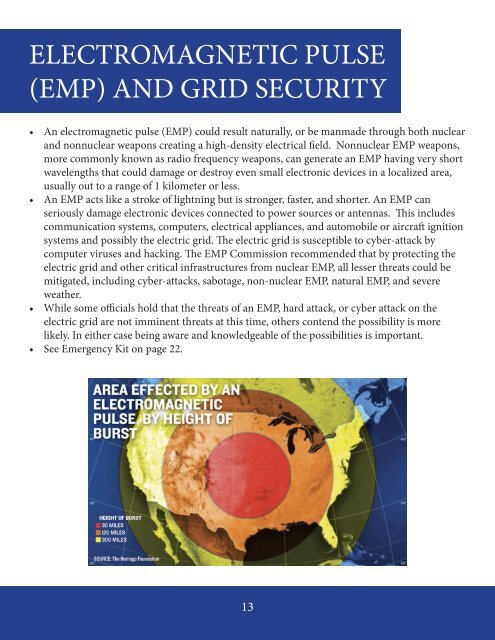Terrorism Preparedness Manual
Terrorism Preparedness Manual
Terrorism Preparedness Manual
Create successful ePaper yourself
Turn your PDF publications into a flip-book with our unique Google optimized e-Paper software.
ELECTROMAGNETIC PULSE<br />
(EMP) AND GRID SECURITY<br />
• An electromagnetic pulse (EMP) could result naturally, or be manmade through both nuclear<br />
and nonnuclear weapons creating a high-density electrical field. Nonnuclear EMP weapons,<br />
more commonly known as radio frequency weapons, can generate an EMP having very short<br />
wavelengths that could damage or destroy even small electronic devices in a localized area,<br />
usually out to a range of 1 kilometer or less.<br />
• An EMP acts like a stroke of lightning but is stronger, faster, and shorter. An EMP can<br />
seriously damage electronic devices connected to power sources or antennas. This includes<br />
communication systems, computers, electrical appliances, and automobile or aircraft ignition<br />
systems and possibly the electric grid. The electric grid is susceptible to cyber-attack by<br />
computer viruses and hacking. The EMP Commission recommended that by protecting the<br />
electric grid and other critical infrastructures from nuclear EMP, all lesser threats could be<br />
mitigated, including cyber-attacks, sabotage, non-nuclear EMP, natural EMP, and severe<br />
weather.<br />
• While some officials hold that the threats of an EMP, hard attack, or cyber attack on the<br />
electric grid are not imminent threats at this time, others contend the possibility is more<br />
likely. In either case being aware and knowledgeable of the possibilities is important.<br />
• See Emergency Kit on page 22.<br />
13


